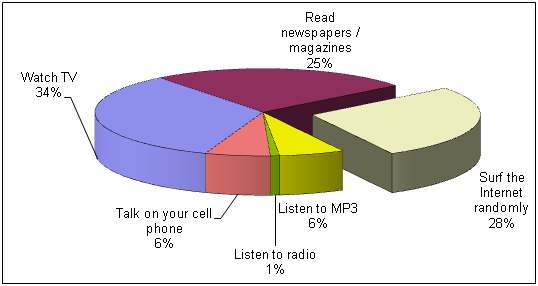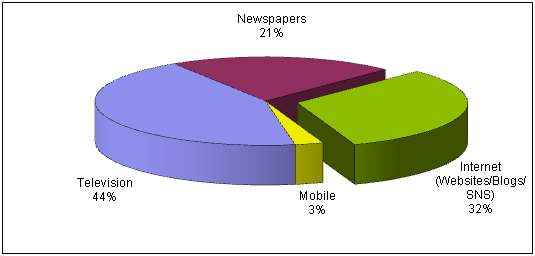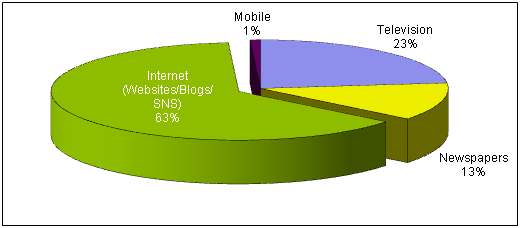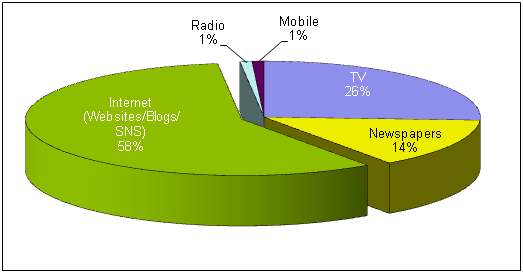This is the second section of the research that we have carried out on social media with respect to India. Do read the first section.
Part 2 – To map out the current usage pattern of social media of Indians
Q5) How much time do you spend everyday on blogs, social networking and uploading photos and videos?

© Windchimes Communications Pvt Ltd
It is really surprising to note that more than 1/3rd of the respondents spend more than 30 minutes everyday on social media sites.
Q6) What do you do when you are online?

© Windchimes Communications Pvt Ltd
Distinctly, people have started engaging in active forms of engagement. From reading and commenting on blogs, to creating profiles, to uploading photos and videos – all signs of people moving away from passive to active forms of engagement. There is a need to involve them if brands want to retain their attention.
Q7) What do you write about in the communities and groups?

- © Windchimes Communications Pvt Ltd
When it came to participating in conversation and discussions online, majority preferred associating with a cause or cause led approach by a brand. Next in line were the celebrities or movies that people preferred commenting and talking about.
Part 3 – To study the impact it has in our purchase behaviour
Q8 Do the comments left on blogs and in communities influence your purchase decision?

© Windchimes Communications Pvt Ltd
Q9) For which categories will you online reviews before doing actual purchase?

© Windchimes Communications Pvt Ltd
The replies for Q8 and Q9 clearly highlight that people are more prone to reading reviews online before carrying out actual purchase. They would carry out the first leve of research – fact finding and opinion seeking – on social media platforms to narrow down their choice.
The categories most influences by this behaviour are:
1. Travel
2. Consumer Durables (I am including Cell Phones in this category too)
3. Automobiles – Both cars and bikes
To Summarize the survey:
1. Surfing Internet scored as the 2nd most medium to be used in spare time overtaking reading newspapers or listening to music.
2. Internet and social media sites are the first places to seek news, products and services related information and to find out about latest trends. In that sense, instead of being afraid of social media, marketers must embrace it.
3. Social media is becoming a part of daily lives. Even if it means just updating profile on social networking site or reading blogs. It is more involving and will eat into the time that was earlier being spent on other entertainment mediums. There are already youtube meet ups being organized where in group of people play their favourite online videos.
4. There is a distinct preference over getting associated with a cause when online. Possibly another reason why online activism is becoming so apparent in modern times. Besides that its entertainment and brands that take the next two slots. The important thing to notice is that if brands or companies adopt the role of thought leadership and Corporate Social Responsibility (CSR) approach, then they are much more likely to succeed.
5. The most critical aspect of the survey is the impact of social media in our purchase behaviour. It is clearly evident that comments left on the blogs, review sites and discussion forums impact the manner of purchase. Lot of brands are make it in the consideration set of the consumers while others are dropped out on the basis of those reviews. It is important for brands to reach out to those users – be present where they are. They will have to build a dialogue with them in those forums and get them to review their product or service.
6. Another fallout for the companies is to track what people are talking about them. They will have to maintain their reputation online. It will be important to listen to what people have to say and act accordingly. That will start by first tracking the social media platforms and then analyzing the information to take strategic decisions.
The objective of this research was to give a peek inside the Indian users understanding and usage of social media. The role it plays in his life and how it will impact companies who want to reach out to them
You can download this research paper by clicking on to Scribd link given below
[scribd id=9690008 key=key-w7frnk7p3pzjlfjbxxv]




